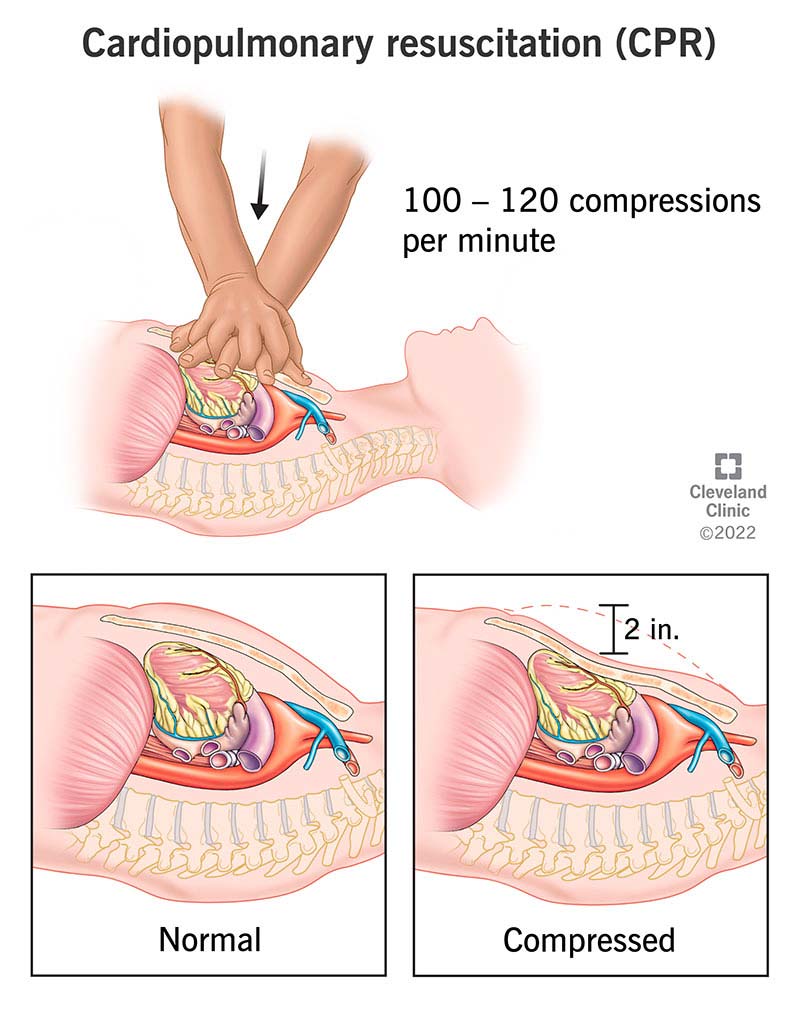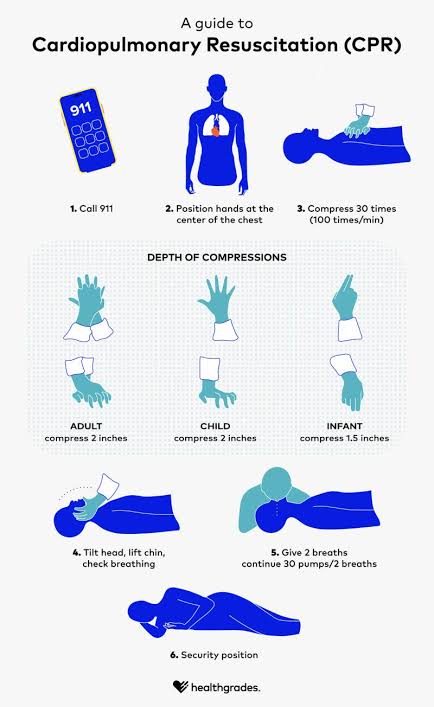Cardiopulmonary resuscitation (CPR) is a vital emergency procedure used when someone’s breathing or heartbeat has stopped, which can occur during events such as heart attacks, drowning, or other life-threatening situations. This technique is designed to keep blood and oxygen flowing to vital organs until professional medical help arrives. CPR combines chest compressions with rescue breaths (in some cases) to restore circulation and breathing.
When the heart stops beating, the body’s organs, including the brain, no longer receive oxygen-rich blood. Without prompt action, brain damage can occur within minutes due to lack of oxygen. Performing CPR can significantly increase the chances of survival by maintaining blood flow and providing a temporary solution until emergency services can take over.
General CPR Guidelines
- Ensure Safety: Before initiating CPR, ensure the environment is safe for both you and the victim. Check if the person is conscious by tapping their shoulder and shouting, “Are you OK?”
- Call for Help: If you are untrained or unsure of your abilities, immediately call 911 or your local emergency number. If you have access to an automated external defibrillator (AED), get it as soon as possible.
CPR for the Untrained
If you are not trained in CPR, the American Heart Association (AHA) recommends performing “hands-only CPR.” This method involves chest compressions only and is suitable for untrained individuals or those uncomfortable providing rescue breaths. Here’s how to perform hands-only CPR:
Chest Compressions: Place the person on their back on a firm, flat surface. Using the heel of one hand, press down on the center of the chest (between the nipples). Place your other hand on top and interlock your fingers. Keeping your elbows straight, push hard and fast at a rate of 100-120 compressions per minute. Allow the chest to fully recoil between compressions. Continue this until medical help arrives.
CPR for the Trained
For those trained in CPR, follow these detailed steps:
- Check Pulse and Breathing: Verify if the person has a pulse and is breathing. If not, start CPR. Begin with chest compressions.
- CPR Sequence: Perform 30 chest compressions followed by 2 rescue breaths. Continue this cycle until emergency services arrive or the person shows signs of life.

Performing Chest Compressions
- Positioning: Place the person on their back on a firm surface. Place the heel of one hand in the center of the chest, between the nipples. Place your other hand on top and lock your fingers together. Keep your elbows straight and your shoulders directly above your hands.
- Technique: Compress the chest at least 2 inches deep (5 centimeters) but no more than 2.4 inches (6 centimeters). Use your full body weight, not just your arms, to push hard and fast at 100-120 compressions per minute. Songs like “Stayin’ Alive” by the Bee Gees can help you maintain the correct rhythm. Allow the chest to fully recoil after each compression.
Opening the Airway
Head-Tilt, Chin-Lift: After performing 30 chest compressions, open the airway by tilting the head back and lifting the chin. Place one hand on the person’s forehead and gently tilt the head backward. Use your other hand to lift the chin forward.
Rescue Breathing
- Mouth-to-Mouth: Pinch the person’s nose shut, cover their mouth with yours, and give two breaths. Each breath should last about 1 second and should make the chest rise. If the chest does not rise, reposition the head and try again. Avoid giving breaths with excessive force.
- Using a Bag-Mask: If available, use a bag-mask device to provide rescue breaths. This is preferable, especially in cases where mouth-to-mouth may be difficult.
Using an AED
- When Available: As soon as an AED is available, turn it on and follow the device’s spoken instructions. Attach the pads to the person’s bare chest as indicated, and deliver a shock if prompted. After giving a shock, continue CPR, starting with chest compressions.
- If Untrained: If you are not familiar with using an AED, a 911 operator can guide you through its use.
CPR for Children and Infants
Children (Ages 1 Through Puberty)
- Compressions: Place the child on their back on a firm surface. Use two hands for compressions if the child is larger, or one hand for smaller children. Compress the chest about 2 inches (5 centimeters) deep at a rate of 100-120 compressions per minute. Continue until help arrives or the child shows signs of life.
- Airway and Breathing: After 30 compressions, open the airway with the head-tilt, chin-lift maneuver. Provide 2 rescue breaths. Use pediatric pads for an AED if available. If no pediatric pads are available, use adult pads.
Infants (Under 1 Year)
- Compressions: Place the infant on their back on a firm surface. Use two fingers to compress the chest about 1.5 inches (4 centimeters) deep at a rate of 100-120 compressions per minute.
- Airway and Breathing: Use the head-tilt, chin-lift maneuver to open the airway. For rescue breaths, cover the infant’s mouth and nose with your mouth and give gentle puffs of air. Each breath should take about 1 second and cause the chest to rise. If the chest does not rise, reposition the head and try again.

When to Perform CPR on a Newborn
CPR for newborns (babies up to 4 weeks old) generally follows a slightly different procedure, primarily due to the need to handle the baby gently. If a newborn is not breathing and you do not know the cause (e.g., choking), perform CPR:
- Compressions: Place the baby on a firm surface. Use two fingers just below the nipple line. Compress the chest about 1.5 inches (4 centimeters) deep at a rate of 100-120 compressions per minute.
- Airway and Breathing: Tilt the baby’s head back slightly and lift the chin. Cover the baby’s mouth and nose with your mouth and give gentle puffs of air. Each puff should last about 1 second and cause the chest to rise.
Continuing CPR and Recovery
- CPR Duration: Continue CPR until the person shows signs of life, or emergency medical personnel arrive. If you become tired, another bystander can switch places with you.
- Post-CPR Care: Once first responders take over, the person will be transported to a hospital. Medical professionals will assess for any organ damage or other issues resulting from cardiac arrest. Survivors may need follow-up care for potential brain damage or other complications.
CPR is a crucial skill that can save lives during emergencies when a person’s heartbeat or breathing has stopped. Whether you are trained or untrained, performing CPR with confidence and urgency can significantly impact the outcome. By understanding and practicing these techniques, you can be prepared to act swiftly and effectively in a life-threatening situation. Remember, the priority is to start CPR as soon as possible and continue until help arrives.
SOURCES
- https://my.clevelandclinic.org/health/treatments/17680-cardiopulmonary-resuscitation-cpr
- https://www.mayoclinic.org/first-aid/first-aid-cpr/basics/art-20056600




